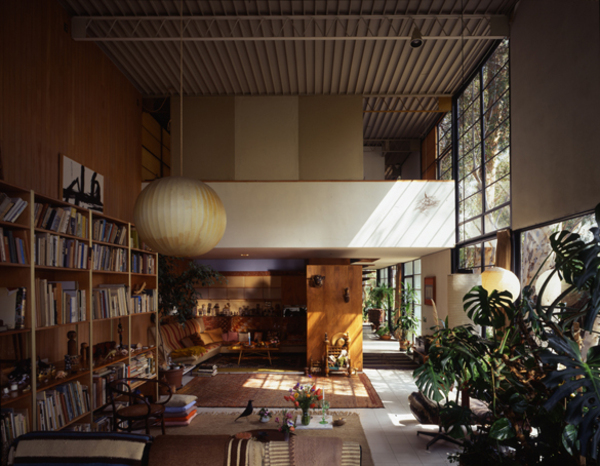
I came to appreciate Ray and Charles Eames late in my architectural career. So late in fact that it was only in mid December that I came to fully appreciate the genius of their epic home built in 1949 in Pacific Palisades, California.
Yes, I had seen it published for decades since my college days. But black and white photographs hardly did it justice, and subsequent color photos never quite convinced me that this industrial/off-the-shelf component kit of parts of steel and glass was worth all the hype. Sure it was clever, but wasn’t it just a wink and a nod to California-based architects by the East Coast architectural establishment so they could wallow in their own innovation and success?
The Eameses’ collaboration on furniture and accessories was certainly innovative, modern, functional, sometimes whimsical, and always unflinching in detail. The name “Eames” gradually became synonymous with all things mid-century, so it came as no surprise that the Los Angeles County Museum of Art has devoted considerable square footage to the designing duo at its current landmark exhibition, “California Design 1930-1965: Living in a Modern Way,” which is on view through April 30.
I took in the exhibition while visiting a project of mine in Pacific Palisades in December. What a mesmerizing show it is. One is literally transported back in time.
Juxtaposed against an Avanti sports car, sleek surfboards, innovative furniture and Krasneresque textiles is the exhibition’s centerpiece—a full-scale two-story re-creation of the Eames House Living Room. The re-creation is accurate to a fault. All that is missing is Charles and Ray luxuriating on the built-in banquette listening to Peggy Lee and George Shearing on the stereo. Even the family’s longtime housekeeper was brought in to consult on the exhibit to ensure that every book and picture frame was placed exactly as the Eameses had intended.
The existing residence is undergoing a major restoration. And since the furnishings, art and objects would need to go into storage, why not build a full size replica, inside and out, of the iconic living room? The result is a triumph and provides astounding evidence of why architecture must be experienced firsthand and not through photographs.
The structure is much smaller than I expected and the materials, while industrial, take on a delicacy and scale completely unexpected. The human scale of the interior is further enhanced by not only the furnishings and towering bookcase—which is chock-a-block with vintage books on design, art, architecture and music—but by a textured and layered effect of building materials that is rarely achieved in architecture today. This effect is sometimes found in modest Japanese homes, some of Frank Lloyd Wright’s houses, and more in recently Paul Rudolph’s Beekman Place aerie—where wall planes don’t quite go to the ceiling, where shelves become ceiling planes, and where doors are somehow more than just door panels.
The room is truly a three-dimensional composition of integrated building elements, which infuses the architecture with humanity. This approach creates mystery to the volume and lets the eye continue, but where and into what?
This great room has qualities reminiscent of Wright’s Taliesin East Living Room, yet a completely different aesthetic was employed. No stone, or stucco or oak here—rather steel, glass, plywood and linoleum—yet the spatial effect was amazingly similar and the recollection of the volume, as at Taliesin, is vivid.
Once the original 1949 Eames residence is restored and reopened to visitors next year, I intend to make the pilgrimage to see the full-blown composition in context with its surroundings. Expect to read about it here. In the interim, if you find yourself in Los Angeles before the end of April, please treat yourself to the show.
Robert Frost’s epic poem “The Road Not Taken” finishes with the line: “Two roads diverged in a wood, and I—I took the one less traveled by, And that has made all the difference.”
Clearly, Ray and Charles Eames chose the correct road. And we are all the richer for it.
Next time: “Under Cover of Darkness.”